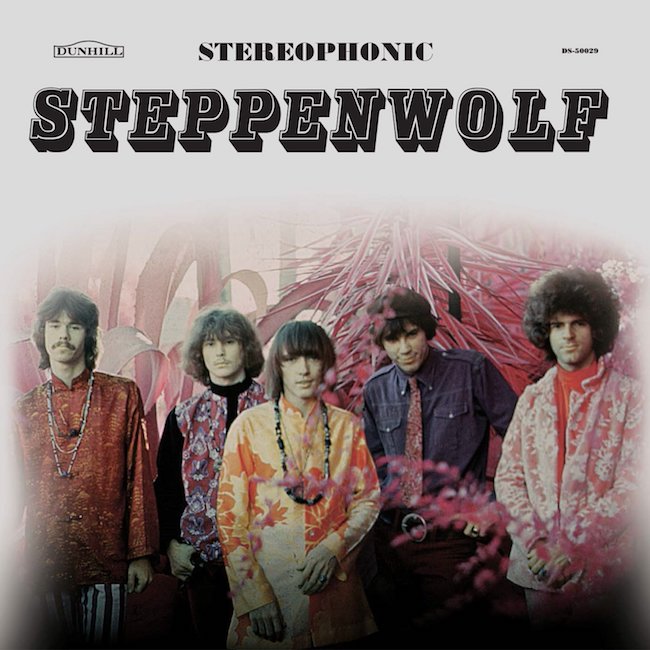 Formed in Toronto and adding two Los Angeles-based musicians, Steppenwolf came on the music scene just as hard rock was heading toward its ascendancy. Looking for all the world like a biker gang, Steppenwolf could have been created by central casting to portray a hard-edged, leather-clad group of rockers. But Steppenwolf was a real group, taking its name from a 1927 novel by Herman Hesse and led by vocalist and guitarist John Kay.
Formed in Toronto and adding two Los Angeles-based musicians, Steppenwolf came on the music scene just as hard rock was heading toward its ascendancy. Looking for all the world like a biker gang, Steppenwolf could have been created by central casting to portray a hard-edged, leather-clad group of rockers. But Steppenwolf was a real group, taking its name from a 1927 novel by Herman Hesse and led by vocalist and guitarist John Kay.
Steppenwolf had released their debut single, “A Girl I Knew” b/w “The Ostrich,” in late 1967, but the 45 went largely unnoticed, making not a ripple on the singles charts. Both tunes would be included on the group’s self-titled LP, recorded in the fall of ’67 and released on January 29, 1968. In fact eight of the album’s 11 tracks would eventually appear on singles as the band’s reputation took off.
For that debut album, the band worked with Gabriel Mekler, house producer at Dunhill Records. Mekler’s résumé at that point was quite thin; his only previous production credits were three singles by the Dunhill act Lamp of Childhood. But working together, Mekler and Steppenwolf crafted a debut that defined the new rock subgenre that would come to be known as heavy metal. (The term would eventually come to represent a very different style of music, but in 1968, heavy rock meant Steppenwolf, Iron Butterfly, Blue Cheer and other loud, aggressive rock acts.)
Steppenwolf opens with the first of three cover songs, a reading of the 1966 Steve Cropper-Don Covay soul tune, “Sookie Sookie.” Where Covay’s original featured a prominent horn section, Steppenwolf’s version features distorted electric guitar. Kay and his band change the key, slow the arrangement down a bit, and mine the blues influences in the song. Goldy McJohn’s gurgling Hammond organ underpins the song while the guitar and rhythm section move it forward. Mid-song the band steps up a key as Michael Monarch takes a short electric guitar solo. More a groove than a song, “Sookie Sookie” nonetheless establishes the hard rock template upon which Steppenwolf would find its fortunes.
Listen to “Sookie Sookie”
“Everybody’s Next One” is cut from some very different musical cloth. Co-written by Kay and Mekler, the tune opens with some baroque-flavored electric piano from McJohn. Eventually the intro gives way to the main melody. While it’s not the most memorable song in the Steppenwolf catalog, the pop-leaning “Everybody’s Next One” does display some Who-like power chording. Rushton Moreve’s bass guitar work makes good use of the instrument’s upper register, inviting further comparisons with the Who.
The title of John Kay’s “Berry Rides Again” provides all the clues needed as to its musical character. Based on some Chuck Berry guitar riffs and arrangement cues, the song is a kind of potted travelogue of Berry’s 1950s and ’60s hits, with lyrics that string together a number of Berry song titles and key phrases. McJohn’s piano is prominently featured throughout, most notably in a double-tracked solo.
Willie Dixon’s blues classic “Hoochie Coochie Man” is next up for the Steppenwolf treatment. Monarch takes his time getting the tune started, spinning out a sinister, smoldering series of licks before the rest of the band enters. The song is taken at the expected measured tempo, providing plenty of space for Kay to engage in his version of blues wailing. McJohn’s organ, with the Leslie speakers spinning wildly, is a centerpiece of the arrangement. The blues-rock boom was just around the corner as Steppenwolf was released, and the band’s reading of Dixon’s song suggests Steppenwolf could have successfully mined that subgenre. But the band had something else entirely in mind.
Related: Steppenwolf and Easy Rider were a perfect match
Mars Bonfire was a songwriting pseudonym of Dennis Edmonton; he and brother Jerry had had been early members of the Sparrows, a band that would eventually morph into Steppenwolf’s first lineup. Jerry would stay on as Steppenwolf’s drummer while his brother concentrated on songwriting. Bonfire would provide the band with its signature tune, “Born to Be Wild.”
With a forceful snap on his snare drum, Edmonton kicks off “Born to Be Wild.” The rest of the band follows immediately. Insistent guitar lines are supported by Moreve’s nimble, expressive bass work. In between John Kay’s gruff vocal phrases, McJohn inserts splashes of Hammond organ, establishing a musical dialogue in the process. The song’s bridges increase the intensity, and that intensity is only partly relieved by the song’s soaring, brief choruses. Monarch slips in catchy guitar fills wherever he can, while Kay sings of racing with the wind and, in the phrase that gave birth to a genre, “heavy metal thunder.” The song’s final 30 seconds feature the band firing on all cylinders, vamping on the song’s signature licks.
Along with “Magic Carpet Ride” from the band’s second album (and its last with the original lineup), “Born to Be Wild” is the perfect distillation of all of Steppenwolf’s virtues. The band’s first hit single (backed with “Everybody’s Next One”), it would also be Steppenwolf’s most successful song, climbing to #2 in Billboard and finding use in countless film soundtracks (Easy Rider being the first and most notable) and becoming a permanent fixture of classic rock radio. Steppenwolf would be repackaged to highlight its inclusion of the song on subsequent re-pressings.
Watch Steppenwolf perform in a 1969 TV appearance
The first minute of “Your Wall’s Too High” is half blues, half pop, with some barroom piano from McJohn. The tempo shifts radically after that, but despite the presence of some inventive licks, it feels musically underwritten. Credited to Kay, “Your Wall’s Too High” sounds like the product of some collaborative late-night jamming. Still, both Monarch and McJohn turn in some memorable work, elevating what’s nearly a one-chord vamp.
A gentle introduction leads into the three-chord meditation of “Desperation.” With different vocals ,the song could almost be mistaken for an early Lynyrd Skynyrd tune a la “Tuesday’s Gone.” Once again it’s the twin firepower of Monarch’s guitar and McJohn’s Hammond (plus, of course, John Kay’s soulful growl) that gives the song what character it has.
Hoyt Axton was, and would continue to be, known primarily as a folk and country songwriter, though he had a number of forays into the world of pop, penning songs that would become hits for Three Dog Night, Ringo Starr and many others. But “The Pusher” stands out among his works as one of his most strident and direct sets of lyrics. The song argues that a drug dealer and a pusher are two very different things, and that the latter is evil.
Released as a single, Steppenwolf’s reading of “The Pusher” didn’t chart; in fact it’s surprising that the song wasn’t banned from playlists of 1968 for its memorable line, “God damn the pusher.” A fixture of the band’s live set as early as the Sparrow days, “The Pusher” features some haunting, searing lead guitar work and an equally memorable rhythm guitar part. McJohn’s Wurlitzer electric piano work is simple yet a tour-de-force. And while it’s buried in the mix, his Hammond organ playing on “The Pusher” is equally tasty. Kay’s emotive, nearly over-the-top vocals suit the song perfectly.
Listen to “The Pusher” as heard in Easy Rider (P.S.—Did you know that the fellow in the cap at the beginning of the scene doing the drugs is Phil Spector?)
McJohn’s harpsichord forms the musical basis of the introductory section of “A Girl I Knew,” Steppenwolf’s foray into baroque rock. It’s a curio, not awful in any way but far less successful than Love’s similarly minded efforts on Forever Changes. Kay’s sandpapery vocals are a bit incongruous set against the tinkling harpsichord. But when the arrangement shifts into a high-powered rocker, it’s a winner. Monarch tears out a fuzz-drenched solo while McJohn adds insistent piano. Toward the song’s end, the fussy arrangement returns, bookending the rock section.
McJohn’s piano is at the center of things once again on “Take What You Need,” a soulful tune that features Kay’s vocals in overdubbed harmony. Another Kay-Mekler co-write, it showcases the pop tendencies of its composers. A false fadeout (a la the Beatles) feels more like a mistake than a production decision.
Steppenwolf closes with “The Ostrich,” a John Kay original with no connection to the early Lou Reed composition of the same name. McJohn’s Hammond organ is joined by a stinging electric guitar, giving way to a Bo Diddley-style beat that moves the song along. Quite similar in feel and arrangement to “Born to Be Wild,” it’s perhaps one of the most underrated songs in the band’s catalog. Interesting chord changes enliven a blues-based melody, and the song features plenty of space for each of the band members to take a turn at showcasing. The final 30 seconds of “The Ostrich” are made up of studio outtakes and noodling, ending the album on a cacophonous note.
Partly on the strength of “Born to Be Wild,” Steppenwolf would climb to the #6 position on the Billboard album chart in 1968, eventually going gold, the first of five Steppenwolf albums (not counting greatest hits collections) to earn the designation. The success of Steppenwolf’s debut release established the momentum that would carry the band through lineup changes and a succession of albums that continued through the middle of the 1970s.
Steppenwolf’s recordings are available in the U.S. here.
- The Black Sabbath Debut LP: Where Metal Began - 07/23/2025
- Bob Dylan’s Masterful ‘Blood on the Tracks’ @50 - 01/20/2025
- Moody Blues’ Ray Thomas: His Final Interview - 01/04/2025

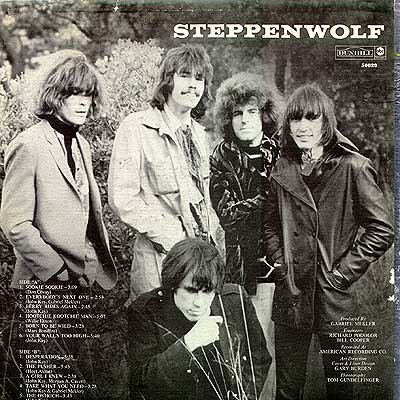

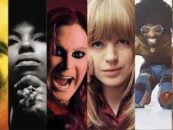
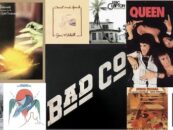
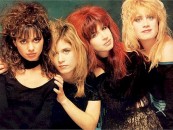

19 Comments so far
Jump into a conversationThis is such a great album and a great band. The lyrics of The Ostrich are timeless.
I love Steppenwolf. I bought Steppenwolf Live when it came out for $3.65. I paid for it in pennies from my pop bottles money and my paper route.
Desperation was a Humble Pie song
As Safe as Yesterday (Humble Pie album) opens with a cover version of Steppenwolf’s “Desperation” according to Wikipedia. Steppenwolf released this album in 1968 and Humble Pie in 1969.
It does – I have the original vinyl LP
nope – the Steppenwolf version was on their first album released in 1968 – the Humble Pie version was on their first album released 1969 …
There needs to be a proper restoration of their original albums.
My very first concert was Steppenwolf in 1969 at the civic opera house in Chicago.It was a great memory that I cherish.Great band and great album.
You’ll still occasionally hear “Born To Be Wild,” or “Magic Carpet Ride” on the radio, but I think many people have largely forgotten how big Steppenwolf was in the heyday, and how influential. In an era of some of the greatest growth of rock music, Steppenwolf was “bad” in the best of ways. You need look no further than those first chords of “The Pusher” in the “Easy Rider” film to feel the absolute cool that Steppenwolf brought to an already pretty heady music scene. The band, itself, doesn’t get enough kudos, as John Kay was such a charismatic singer both sonically and visually, and had so much to do with Steppenwolf’s darker allure and gritty sound. But as great as Kay was, the band’s sound and songs were certainly about more than just him.
Da Mick, I love your comments. So well said. I was fortunate to promote Steppenwolf and John Kay/Steppenwolf concerts in the midwest over a couple of decades and they always hit a Grand Slam at their Shows. They are missed out there “live” but I understand time is tough to beat and I get it.
Wonderful band from then until they quit touring a couple years back. As far as I know they were the only band to carry an MIA banner on stage at the start of the show and take it with them at show’s end. I’ve always thought of Steppenwolf as a lesson in self reliance. At least it was that way for a 15 year old kid. Find “Slow Flux”. They need to be in the Hall of Fame.
While MCR and BTBW were great songs, it’s a shame Ostrich, Hippo Stomp, Power Play, and Renegade didn’t get more air time.
Although the first two Steppenwolf albums were great, nobody ever mentions their 3rd album, Monster, which was equally great. “There’s a monster on the loose, it’s got our head into a noose, and it just sits there…waiting…” to quote the title song. Kay was a great lyricist.
Their third album was actually At Their Birthday Party with “Rock Me” the single off of it. Monster was LP #4.
Their Monster LP is even more relevant today than when it was released. It’s worth listening to again.
The government is indeed a monster!
Steppenwolf 7 is a desert isle must have. A complete 10 out of 10. But sorely overlooked.
Agreed. And it includes the best Steppenwolf song title ever: “Earschplittenloudenboomer”.
Great band, great voice, great tunes. I used to pick John Kay up at LAX back in the 70’s ( I was working for Columbia/MUMS records). He was/is always will be a major Fav of mine.
I can’t believe they’re not in the Rock & Roll Hall of Fame!! As far as I’m concerned it’s the Hall of SHAME.